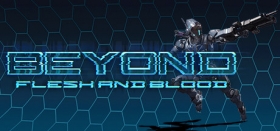
Beyond: Flesh and Blood Preview
In a future where London falls into the Thames, parliament relocates to Manchester and some sort of war forces the majority of the population off planet, it seems natural to have mechs controlled by people up in a space station. Beyond: Flesh and Blood takes you right into that future, with you taking control of disembodied United Global Remnant (UGR) engineer Ethan.
The main mechanic of Beyond is taken straight from Watch_Dogs: the ability to hack electronics like mechanical doors or cameras. At the very beginning, before being assigned a mech, you can move around the UGR compound by jumping between security cameras as a way of teaching that mechanic. I felt this was a little overused at times, especially when I “hacked” an elevator button I was standing right next to.
In order to control the mech from space, you need to be in signal range of a UGR tower; these towers distribute power to nearby electronics and form the centre point of several set pieces in the game. This would be an excellent mechanic for a much larger game that has more paths to follow, where you have to call down towers to allow you to explore more, but in Beyond it just forces you to stay in one place for a while and extend the length of what levels are in the game.

A live feed to Manchester
That’s not to say that the levels aren’t nice to be in: the streets of Manchester in 2281 are simultaneously futuristic and overgrown, with grasses, trees and vines climbing up the sides of bright, glassy buildings. Inside, the walls are covered in a fleshy-looking plant that looked like it was breathing. The world Beyond is showing us is very interesting and detailed, and you can tell that it comes from an appreciation of the setting.
Inhabiting those levels are wild dogs that look like the Borg from Star Trek, with robotics bursting through the skin, and ordinary people that are referred to by your allies as rebels. In the hour and a half of gameplay, these were the only enemies I actually fought, though at the very end a new enemy was introduced: an insect larger than a person scurried away over a bus and we’re told that we don’t have clearance to know more about them.
Through the levels, you control a mech: the first is a standard construction mech with a cutting laser. Initially, you’re tasked with moving boxes and hacking terminals inside a UGR compound, though after a disturbance outside you’re tasked with investigating. This leads you down the path that lands you mech number two, with a slightly different cutting laser and punching hands.

This robot is not in disguise
This is something that bothered me: during your time with the first mech, you receive an upgrade that doesn’t land quite where it was aimed, and you have to retrieve it. Your handler, a very chatty man who is devoutly loyal to the UGR, reminds you to not waste company resources by leaving this upgrade - a jump boost - unattended on the surface. Then, barely ten minutes later, you leave an entire mech - with the jump boost - unattended on the surface in favour of a new mech.
That’s not the only part of the writing that I found odd: one of the main focuses of the combat is the glory kill system, where low enemies are literally ripped in half. This was a little shocking at first, since nothing up to that point had hinted that you were playing a homicidal maniac, but the animations are reasonably satisfying and it saves trying to use the ranged combat. However, towards the end of what story is currently available, one of the friendly NPCs chastises you for killing so willingly, and reminds you that those are real people you’re killing. I can only assume that this is setup for an overarching story about animosity between people living on the ground and those up in space, but at the moment it feels off-key to the rest of the game.
While I’m nitpicking: the animations of the people could do with some work, as while the mechs are reasonably fluidic, the general animations look strange on the much smaller people models. Also, the camera needs a lot of work to prevent it becoming stuck in terrain in the tighter corridors, and follow the mech better during fast moving sections. I did appreciate how they explained the third person perspective, with other mechs being followed by a flying camera. The control prompts also are occasionally wrong, and the game was clearly designed for controllers since it often defaults to controller prompts.

This is what Wi-Fi looks like
There is an arena survival mode where you must defeat waves of enemies, and this is honestly where you’ll get the most time out of the game at the moment. The first couple waves are very easy, then later waves destroy you with little warning, and the indication of where enemies are is poor. The arena is dark and it’s difficult to see targets until they’re already firing on you, despite a scan function that I honestly couldn’t tell if it works or not.
Overall, I will recommend Beyond: Flesh and Blood, but when it is actually finished. As a story-based game, even with the arena mode, I couldn’t recommend playing it with only a fraction of that story. If you already like the idea of it, buy the game now because when it’s done the price will go up, but if you’re not convinced wait until the full reviews come out in approximately six months to a year.







COMMENTS